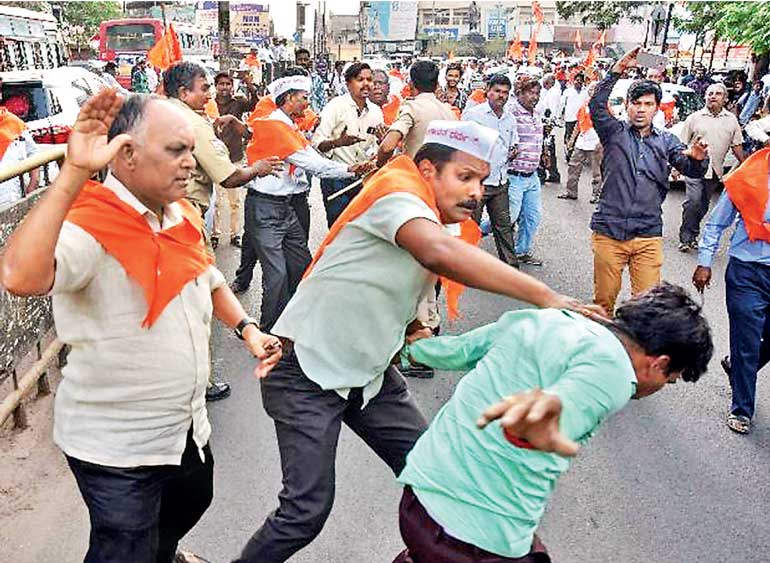Sunday Dec 07, 2025
Sunday Dec 07, 2025
Saturday, 24 March 2018 00:57 - - {{hitsCtrl.values.hits}}

The year 2018 is likely to see the birth (or official recognition) of a new religion in India, adding to the six already in existence and recognised by law. It is Lingayatism, found mostly in the South Indian States and Maharashtra.
If all goes well, Lingayatism will join recognised religions such as Hinduism (79.8%), Islam (14.2%), Christianity (2.3%), Sikhism (1.7%), Buddhism (0.7%), and Jainism (0.4%). The percentages are as per the last census taken in 2011.
If the Karnataka State government’s decision to recognise “Lingayatism” as a separate religion from “Hinduism” is endorsed by the Central government in New Delhi, the “Lingayats” will be designated as a “religious minority” or more commonly as a “minority”.
And as a “minority” the Lingayats will be entitled to special privileges and protections such as the right to run their own religious and educational institutions; access to funds allocated for the development of religious minorities; reservation in jobs in States which have reservation for religions minorities; and the protection of the Minority Commissions in the States and the Centre.
Why separate status?
The common view is that the Lingayats, who are found in Karnataka (11 million), Maharashtra (15 million), Telengana (eight million) and Tamil Nadu (five million), are only a “caste” within the Hindu socio-religious fold. But Lingayats have been protesting against this description and categorisation for long, arguing that the tents of Lingayatism are at total variance from Hinduism.
They have also been protesting against people clubbing them with the “Veerashaivas” just because both worship the Hindu god “Shiva”. Lingayats are also called “Veerashaivas” although the Veerashaivas are a distinct community. Confusion with the Veerashaivas and the mix up in the nomenclature are due to the notion that both Veerashaivas and the Lingayats worship the Hindu God Shiva.
But the Lingayats point out that the “Shiva” they worship is not the Shiva that the Veerashaivas or the Hindus worship. Their Shiva is a spiritual power which resides within individuals. They call this spiritual power “Istha Linga” which is not the “Linga” (the phallic symbol) associated with the Hindu God Shiva. According to the Lingayat scholar, M.G. Mahadevappa, the Shiva of the Lingayats is “universal consciousness qualified by universal energy (Shakti).” It has no form or shape. It is a thought, a value.
As far back as the 1871 Mysore State census, the Lingayats were classified as being different from the Hindus. This was because the tenets of Lingayatism are different from those of Hinduism.
Unlike Hinduism, Lingayatism is anti-caste, and stresses gender equality. It does not recognise the authority of the Vedas, and is against ritual sacrifices and idol worship. In fact, it does not even believe in temple worship of the “agamas” which are a distinctive feature of Hindu religious practice.
Lingayatism rejects the Shastas, Smritis and the Upanishads, which are the core of Hinduism. It explicitly rejects Brahminism. Thus, Lingayatism has no priesthood though there are Lingayatspiritual centres called “Mathas” or Mutts, with ascetics practicing and propagating Lingayatism. But they are not priests.
The Veerashivas, on the other hand, are Hindus in every way. But their idol is God Shiva, almost exclusively. Though the Veerashaivas trace their origin to the 12th century sage/social reformer Basavanna or Basaveshwara, the originator of Lingayatism, they do not follow the “Vachanas” or the tenets expounded by Basavanna. They follow the Hindu Vedas and Agamas.
 The Lingayats have been complaining about the “oppression” of the Veerashaivas, accusing the latter of imposing Hindu thoughts and practices on the Lingayats, contradicting the teachings of Basavanna. No wonder, the Veerashaivas have been opposing the Lingayats’ movement to break away from Hinduism and declare themselves a separate religion.
The Lingayats have been complaining about the “oppression” of the Veerashaivas, accusing the latter of imposing Hindu thoughts and practices on the Lingayats, contradicting the teachings of Basavanna. No wonder, the Veerashaivas have been opposing the Lingayats’ movement to break away from Hinduism and declare themselves a separate religion.
The Lingayats’ struggle has been on for long. When the Indian constitution was drafted in 1948-49, Lingayat members of the Constituent Assembly, such as S.Nijaligappa, H.Siddhaveerappa, B.N.Manavalli and Ratnappa argued for Lingayatism being listed as a distinct religion.
‘If Buddhism, Sikhism and Jainism could be designated as separate religions, why cannot Lingayatism be?’ the Lingayat leaders have been asking for the past seven decades.
Why surface now?
While it is not at all surprising that the Lingayats should ask to be classified as a separate religion, the issue coming to the fore now can be attributed to current politics.
Karnataka State will be going for elections in about a year from now and various issues are coming to the fore, including demands of various interest groups including socio-religious groups like the Lingayats.
Astute as he is, the Congress Chief Minister of Karnataka, Siddarmaiah, moved fast and got the State cabinet to pass a proposal to declare Lingayatism a separate religion on the basis of a report of a State government sponsored study team.
If the Lingayats are pleased, they could swing the vote in the Congress party’s favour in 110 of the 200-odd electoral constituencies in Karnataka State.
BJP in a fix
The ruling Congress party’s move has put the opposition Bharatiya Janata Party (BJP) is in a fix. BJPs’ State level leader B.S. Yeddyurappa is a Lingayat and had been a great advocate of the cause of the Lingayats. But after he joined the BJP, he has been forced to speak for the unity of Hindus and oppose any divisive tendency tooth and nail.
But now he has let the issue to the wisdom of the Lingayat and Veerashaiva organisations. They could argue the issue out and come to an understanding, which he would abide by, Yedyurappa has said.
But it is too late for any understanding or compromise between the two sects. The Congress government in Karnataka has set the ball rolling and it is not possible for any one now to stop the Lingayats from getting their due – Hindutwa or no Hindutwa. The Hindutwa Juggernaut can only go thus far and no further in India, the land of diversity.